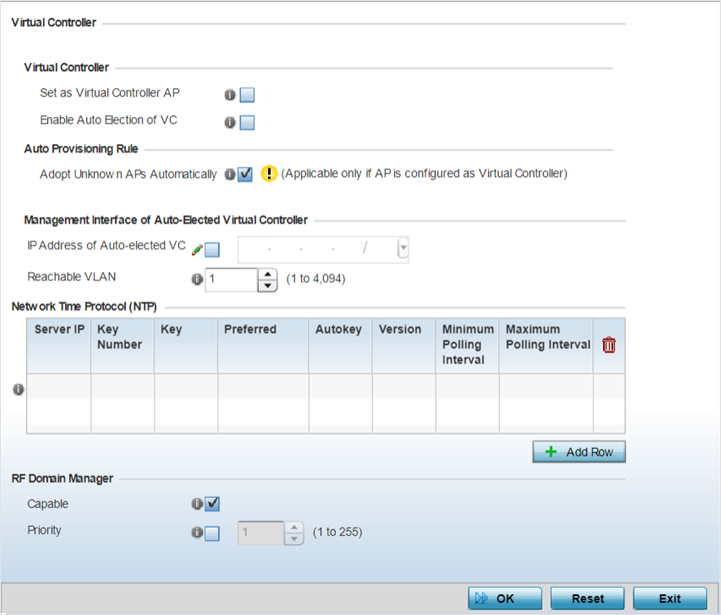Configure AP Profile General Settings
About this task
An access point profile requires unique clock synchronization settings as part of its general configuration.
The Network Time Protocol (NTP) is a client-server implementation that manages time and/or network clock synchronization within the network. Controllers, service platforms, and access points (NTP clients) periodically synchronize their clock with a master clock (an NTP server). For example, an access point resets its clock to 07:04:59 upon reading a time of 07:04:59 from its designated NTP server.
To define a profile‘s general configuration:
Procedure
-
Select
Configuration → Devices → System Profile
from the Web UI.
A list of device profiles is displayed in the right-hand UI. This list contains default and user-defined profiles.
-
Select a
device profile from the list.
General configuration options display by default, with the profile activated for use with this access point model.
 General Profile Screen
General Profile Screen
- Select the Set as Virtual Controller AP checkbox, to configure this AP as VC.
-
Select the Enable Auto Election of VC checkbox to enable
AP as a Dynamic Virtual Controller (DVC). DVC enables/disables
auto-selection of AP as VC.
When enabled, the AP on being elected as the RF Domain manager takes on the role of the virtual controller. In an RF-Domain, DVC can be enabled on multiple access points. However, only the current RF-Domain manager AP has a running instance of the DVC. This option is applicable only if enabling DVC.
If you have enabled DVC on RF Domain APs, configure management interface details.

Note
MLCP discovery does not function on APs enabled as VC or DVCs. Do an explicit “mint link vlan X” on the AP‘s device/profile context, or “control-vlan X” in the AP‘s RF-Domain context, to establish MiNT links between the VC and its adopted APs.
Note
DVC is not supported on the new 802.11ax APs. - If you set the AP is a VC, select the Adopt Unknown APs Automatically checkbox.
-
If enabling DVC, use this option to configure the Management
Interface of Auto-Elected Virtual Controller. Configuring the
management interface ensures failover in case the RF Domain manager is
unreachable.
IP Address of Auto-elected VC Select the checkbox and enter the management interface IP address. Due to the random nature of DVC, specifying an explicit management interface IP address makes it easier to manage VCs. In case of fail over, this IP address is installed as the secondary IP address on the new VC.
Reachable VLAN Specify the VLAN from 1 - 4094 on which the management interface IP address is configured. For DVC, configuring management-interface ip address is mandatory. However, VLAN configuration is optional. If you configure the ip address without specifying the VLAN, the system configures the specified ip address as secondary ip on VLAN 1.
-
Select + Add Row below
the Network Time
Protocol (NTP) table to define the configurations of NTP server
resources used to obtain system time. Up to three NTP servers can be configured.
Set the following parameters to define the NTP configuration:
Server IP Set the IP address of each server added as a potential NTP resource. Key Number Select the number of the associated authentication peer key for the NTP resource. Key Enter a 64 character maximum key used when the autokey setting is set to false (disabled). Select the Show option to expose the actual character string comprising the key. Preferred Select this option to designate this NTP resource as a preferred NTP resource. This setting is disabled by default. AutoKey Select the check box to enable an autokey configuration for the NTP resource. The default setting is disabled. Version Use the spinner control to specify the version number used by this NTP server resource. The default setting is 0. Minimum Polling Interval Use the drop-down menu to select the minimum polling interval. Once set, the NTP resource is polled no sooner then the defined interval. Options include 64, 128, 256, 512 or 1024 seconds. The default setting is 64 seconds. Maximum Polling Interval Use the drop-down menu to select the maximum polling interval. Once set, the NTP resource is polled no later then the defined interval. Options include 64, 128, 256, 512 or 1024 seconds. The default setting is 1024 seconds. -
Use the RF Domain Manager
field to configure how this access point behaves in standalone mode. Set the
following parameters:
Capable Select to enable this access point to act as a RF Domain Manager in a particular RF Domain. Priority Select to prioritize this access point in becoming a RF Domain Manager in its; particular RF Domain. The higher the value, the more likely the device becomes the RF Domain Manager for the domain. -
Select
OK to save the changes made to the general
profile configuration.
Select Resetto revert to the last saved configuration.


